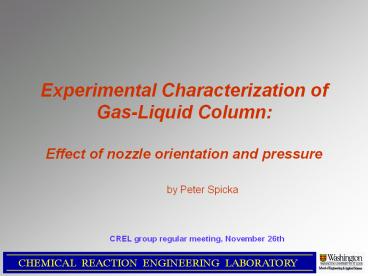Gas-Liquid Columns: Experimental Characterization and CFD Simulations - PowerPoint PPT Presentation
1 / 11
Title:
Gas-Liquid Columns: Experimental Characterization and CFD Simulations
Description:
Experimental Characterization of Gas-Liquid Column: Effect of nozzle orientation and pressure by Peter Spicka CREL group regular meeting, November 26th – PowerPoint PPT presentation
Number of Views:120
Avg rating:3.0/5.0
Title: Gas-Liquid Columns: Experimental Characterization and CFD Simulations
1
Experimental Characterization of Gas-Liquid
Column Effect of nozzle orientation and
pressure by Peter Spicka
CREL group regular meeting, November 26th
2
Objective
- Study the sparger nozzle orientation effect on
gas hold-up, liquid velocity and turbulence in
gas-liquid column
Motivation
- Only few data, i.e. liquid velocity and gas
holdup, available in the literature for
churn-turbulent flow regime - CARPT and CT techniques allow relatively accurate
acquisition of needed data - Different pressures and UGS can be covered
- Additional experimental database for CFD
simulations can be created
3
Experiment
- 6.375 stainless steel column
- Cross-sparger, two nozzle orientations facing
upward and downward - Air-water system
- Dynamic height maintained at 11 D
- Pressure 1 bar and 4 bars
- UGS 5 cm/s (only CT) and 20 cm/s
- CARPT setup
- Typical setup, 30 detectors
- Only photo peak acquisition
- 50 Hz sampling frequency
- CT setup
- 5 detectors, 7 projections per view
- 4 axial levels 2.5D 3.5D 5.5D and 9D
- 20 Hz sampling frequency
4
Detector alignment and calibration
CT CARPT
5
CT Results Effect of Nozzle Orientation- Global
View
Gas holdup at UGS20 cm/s and p1 bar
nozzles facing downward nozzles facing
upward
- Bubbles formed from nozzles facing upward are
smaller Þ increased hold-up - Similar behavior was found for all the studied
regimes
6
CT Results Effect of Nozzle Orientation and
Pressure
Gas holdup profiles UGS5 cm/s
UGS20 cm/s
- Nozzle orientation
- particularly pronounced at high pressure and high
UGS in the sparger zone - diminishes with axial position
- Pressure
- Typical increase of gas holdup magnitude
7
Axial velocity profiles Radial
velocity profiles
CARPT Results Liquid velocity
- Steeper velocity profiles observed at high
pressure Þ higher bubble momentum - However, effect of nozzle orientation on liquid
velocity is visible only at near-sparger region
8
Liquid velocity calculation
- CARPT processing algorithm considers uniform time
step - However, relatively large amount of data is
excluded from calculation (25 and more)
- Time step is non uniform
- Calculated velocity will be biased towards higher
values
Comparison with Boon Chengs data
9
CARPT Results Turbulent kinetic energy
Nozzles facing down Nozzles facing up p 1
bar p 4 bars p 1 bar p
4 bars
- Turbulent kinetic energy is higher for nozzles
pointing downward and at higher pressure - Nozzle effect is significant mainly at low
pressure - Significant effect of bubble-induced turbulence
10
CARPT Results Reynolds stresses
- uxux are approximately 2.5 x higher than urur
and they are weakly coupled - Magnitude of uxux is comparable with the
corresponding mean velocities - Highly anisotropic flow !
11
Concluding Remarks
- Nozzle orientation
- Significant effect on gas holdup and turbulent
kinetic energy mainly near the column bottom - More pronounced at high UGS and high pressure
- Effect on liquid velocity profiles is less
significant - Uncertainty in magnitude of turbulent parameters
due to gas holdup fluctuations
Outlook for future
- Filtering
- Elimination of gas holdup fluctuations from CARPT
data - CFD
- Examination of nozzle orientation effect in
churn-turbulent regime































